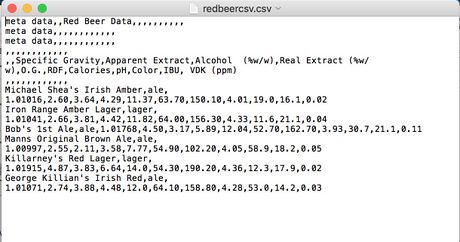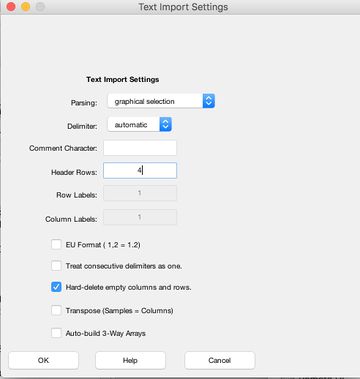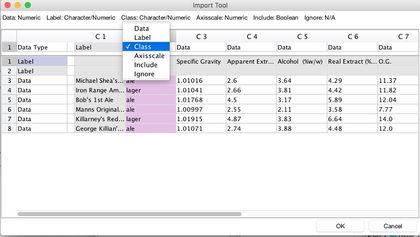Importtool: Difference between revisions
imported>Mathias |
No edit summary |
||
| (10 intermediate revisions by 2 users not shown) | |||
| Line 19: | Line 19: | ||
==Examples== | ===Examples=== | ||
Here we import a csv file by dragging the file into the browse window. | |||
Taking a look at the file we are attempting to import, we see that we have 4 lines of meta data + blank lines, so we set the 'header rows' field to 4 in the text import settings window. The automatic delimiter detection is being used in this example, however the user may force the use of a specific delimiter by selecting it in this window. | |||
[[Image:csv_examp.jpg||460px|]] | |||
[[Image:Text_import1.jpg||360px|]] | |||
The importool will attempt to automatically detect label columns. Here the first column containing the names of beers has been automatically detected as a label column. The third column, containing class information of either 'ale' or 'lager' has also been automatically detected as a label column. To set this column to a class column, click where it says 'label' underneath C2 and select class. The importer will now populate the datasets'class field with the information contained within this second column. | |||
[[Image:importtool1.jpg||420px|]] | |||
====Important Note==== | |||
The importtool view will show the first rows from the text file, up to a maximum of 50 rows. The entire file will be imported when you click the "Ok" button to complete importing the file, regardless of how many lines are in the file. There is no hard-coded limit to the number of lines which can be imported from a text file. | |||
Latest revision as of 21:57, 9 May 2021
Purpose
GUI for designating column/row data types in incoming data. Allows user to specify a column or row as labels, class sets, or axisscale or data.
Synopsis
- [ctypes, rtypes] = importtool(data);
- [ctypes, rtypes] = importtool(data,options);
Description
Allows user to identify data type (data, class, axisscale, include, and ignore) fields (row and columns) in a data matrix.
Options
options = a structure array with the following fields:
- fields: Nx2 cell array, first column is field name, second column is color to use.
Examples
Here we import a csv file by dragging the file into the browse window.
Taking a look at the file we are attempting to import, we see that we have 4 lines of meta data + blank lines, so we set the 'header rows' field to 4 in the text import settings window. The automatic delimiter detection is being used in this example, however the user may force the use of a specific delimiter by selecting it in this window.
The importool will attempt to automatically detect label columns. Here the first column containing the names of beers has been automatically detected as a label column. The third column, containing class information of either 'ale' or 'lager' has also been automatically detected as a label column. To set this column to a class column, click where it says 'label' underneath C2 and select class. The importer will now populate the datasets'class field with the information contained within this second column.
Important Note
The importtool view will show the first rows from the text file, up to a maximum of 50 rows. The entire file will be imported when you click the "Ok" button to complete importing the file, regardless of how many lines are in the file. There is no hard-coded limit to the number of lines which can be imported from a text file.


